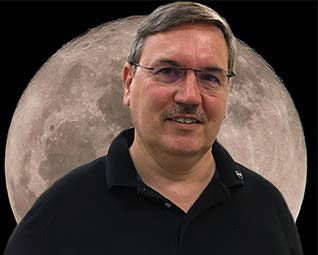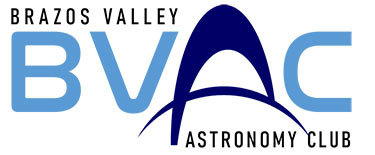

By Tom Campbell
In Greek mythology, Cassiopeia was the queen of Aethiopia (not modern Ethiopia), and the mother of Princess Andromeda. She was a vain woman and would often brag that she or her daughter was more beautiful than all the Nerieds (nymph-daughters of the sea god Nereus). Poseidon was so enraged by her boasting, he tied Cassiopeia to her throne and threw her into the heavens, forever swinging in circles around the celestial pole.
For the Arabs, the stars of Cassiopeia were known as the Tinted Hand, and probably referred to the hand of Fatima, Mohammed's daughter, stained with blood.
In modern times, Cassiopeia resembles a bright W in the sky that's visible at some point during the night for most of the year, but is seen all night long in the autumn. The Perseus Arm of the Milky Way goes through the heart of Cassiopeia, making this region of the sky rich with stars and open clusters.
Achird (η Cas) is a double star system where the two components are separated by 71 AU, or almost twice the distance from our Sun to Pluto. The primary, η Cas A, is a yellow dwarf, much like our own Sun. η Cas B is an orange dwarf, about half as large, and the pair complete one orbit every 480 years.
This binary is naked eye and easy to find. It's the bright yellowish star a little out of alignment from the main W of stars, about one third the way from Schedar and Navi.
Visually, the pair can easily be split in a small telescope. There are a few bluish non-related stars in the same field, which makes a nice color contrast with the binary system.
Iota Cas (ι Cas) is a quintuple star system. ι Cas A is a white star and has Sun-like companion orbiting it once every 49 years. ι Cas B is a yellow-white star which completes an orbit around &iota Cas A every 2,400 years. ι Cas C
Finding ι Cas is pretty straightforward. Simply extend the imaginary line linking Ruchbah and Segin to about the same distance again, turning it slightly towards the North Star. ι Cas should be the brightest star in the field.
Only three members of the Iota Cas system can be detected visually. Components A and B can be resolved relatively easily, but the fainter C component is very close to the bright primary and will need to be coaxed out at high magnification.
WZ Cas is a deep red carbon giant star over 600 times the radius of our Sun. It is a dying star and even though it has a luminosity over 12,000 times that of the Sun, its surface temperature is only 5,000°F (compared with our Sun's 10,000°F).
The visual companion is a hot blue star that provides a pleasing contrast in the eyepiece, but radial velocity measurements for both stars indicate they are not traveling together through space and aren't physically related.
You can locate this pair just past Caph, not too far from NGC 7790. They can be easily separated in a small telescope and make a beautiful blue-orange double.
The Salt & Pepper Cluster (Messier 52) was discovered by Charles Messier in 1774. It is about 9.5 light years across and contains about 6,000 stars. Although only about 158 million years old, the cluster's core is lacking the typical amount of interstellar matter, which possibly indicates multiple supernovae explosions in the past.
To find M52, continue the imaginary line from Schedar to Caph and double its length. At medium magnifications through a telescope, the rich and compact cluster will appear somewhat round, with one bright member and all the other stars appearing one to three magnitudes fainter.
Messier 103 is a small open cluster, containing only a few hundred mostly faint stars within 15 light years of each other, and about 10,000 light years from Earth.
The cluster be easily found near the bright star Ruchbah. Although visible in binoculars, it will take a telescope to resolve many of the fainter stars. The overall shape is triangular. With larger instruments, a bit of color can be detected in a few of the stars.
The E.T. Cluster (NGC 457) was discovered by William Herschel on August 18, 1780 with a 6-inch reflector. It features about 150 stars between magnitudes 9 and 13, and is located 7,922 light years away from Earth. The two brightest stars resemble a pair of gleaming eyes, which lends itself to people imagining many different shapes for the cluster.
It is still unknown whether the brightest star (φ Cas) is actually a true member of the cluster, or just a foreground star. If it is a member, it would be one of the most luminous stars in the sky, surpassing even Rigel.
To find the cluster, I like to imagine a 30-60-90 triangle, with the line connecting Navi and Ruchbah as its base. From Ruchbah, make a line about 90 degrees from Navi and about half as far. This should put you on a bright "double star" in the finderscope. These will be the "eyes" of the cluster.
NGC 457 is a fun cluster to show at star parties. E.T. Cluster is one of its more modern names. It has also been called the Owl Cluster, Dragonfly Cluster, and even Kachina Doll Cluster. This indicates that people see a lot of different things when they try to figure out its overall shape. What do you see?
NGC 654 is an open cluster discovered by William Herschel in 1787. This is a small, compact cluster, containing about 80 known members. It is believed to be part of the Cassiopeia OB8 stellar association, forming at the same time as M103, NGC663, and NGC659.
The cluster is located about halfway between Ruchbah and Segin, and is in the same finderscope view as NGC 663. It will take a bit of magnification to resolve many of the stars. To me, it resembles a small bag full of stars, with a line of fairly bright stars forming a "drawstring" to keep them contained.
The Lawnmower Cluster (NGC 663) is a rich open cluster of about 400 stars and was discovered by William Herschel in 1787. It contains two red supergiants at one edge, which add to its beauty.
To find NGC 663, look about halfway between Ruchbah and Segin, and just a little farther out than NGC 654. It is much larger than NGC 654 and the brighter stars form a sort of diamond shape. The center of the cluster seems to have fewer stars than the edges, due to an intervening molecular dust cloud between the cluster and Earth.
Caroline's Rose (NGC 7789) is so-named because it was discovered by Caroline Herschel on November 1, 1783. Her brother William included it in his catalog in 1786 and gave her credit for the discovery. The entire cluster is 50 light years across and covers an area of sky about equal to the full Moon. It contains about 1,000 stars ranging in magnitude from 11-18.
I find NGC 7789 by making a 30-60-90 triangle using Caph and Schedar as the baseline. Make an imaginary line about half that distance and at a right angle, and you should be within the finder view. If you can find ρ Cas and σ Cas in the finder, NGC 7789 should lie right between them.
Even in a 6-8 inch telescope, the cluster appears faint but rich, containing dozens of stars. The cluster is mostly round and has a cigar-shaped knot of stars a little offset from the center.
The Muscleman Cluster (Stock 2) was first catalogued in 1955 by the German astronomer Jürgen Stock. It consists of 54 stars of approximately magnitude 8 that resembles a stick figure flexing his muscles.
This cluster sits right next to the more famous Perseus Double Cluster and is fun to view, even in binoculars. In a telescope, it is best seen at low power due to its large size.
Although very difficult (if not impossible) for the urban observer, these celestial delights are worth the effort of finding darker skies. I have not personally viewed any of these objects yet, but they are on my list of things to attempt.
The Heart Nebula (IC 1805) covers almost 2 full degrees of sky (four times larger than the full Moon), so requires a fast telescope and low magnification to take it all in. Even then, most of the details will be too faint to be seen visually and can only be detected by long exposure photographs.
An exception to this is the inner core of the Heart Nebula, which has been separately catalogued as NGC 896. This nebulosity was first discovered by William Herschel on November 3, 1787. Dark skies and an O-III or H-beta filter are very helpful.
At the outer edge of the Heart is another bright patch known as the Fish Head Nebula (IC 1795). Again, the darker your sky, the better your chances of picking this one up, and an O-III or H-beta narrowband filter improve your odds considerably.
You can't have a heart without a soul, and the sky is no exception. Very close to the Heart Nebula you will find the Soul Nebula (IC 1848). Several small open clusters (Cr 64, Cr 632, Cr 634) are embedded within this emission nebula, which can be detected with a telescope.
| Object | Type | Mag(s) | Dist. (ly) | R. A. | Dec. |
|---|---|---|---|---|---|
| Achird (η Cas) | Double Star | 3.4, 7.5 | 19 | 00h 49m | +57° 49' |
| ι Cas | Quintuple Star | 4.6, 6.9, 9.1 | 22 | 02h 29m | +67° 24' |
| WZ Cas | Carbon Star with Optical Companion | 6.3 - 8.8 | 1,540 | 00h 01m | +60° 21' |
| M52 (Salt&Pepper Cluster) | Open Cluster | 7.3 | 4,600 | 23h 25m | +61° 36' |
| M103 | Open Cluster | 7.4 | 10,000 | 01h 33m | +60° 42' |
| NGC457 (ET Cluster) | Open Cluster | 6.4 | 7,922 | 01h 20m | +58° 17' |
| NGC654 | Open Cluster | 6.5 | 7,830 | 01h 44m | +61° 53' |
| NGC663 (Lawnmower Cluster) | Open Cluster | 7.1 | 7,922 | 01h 46m | +61° 15' |
| NGC7789 (Caroline's Rose) | Open Cluster | 6.7 | 7,600 | 23h 57m | +56° 42' |
| Stock 2 (Muscleman Cluster) | Open Cluster | 4.4 | 1,050 | 02h 15m | +59° 14' |

About the Author:
Tom Campbell is a software developer, children's book author, and NASA/JPL Solar System Ambassador who is frequently seen sharing his love of the universe with others.
Website: http://astro.tomandjul.com/

Fall 2023 Newsletter